May 04, 2022
![]() 26 mins Read
26 mins Read

Take in the picturesque countryside around the Huon Valley (Image: @HuonValleyCouncil)
In a land as vast as Australia, road trips often mean long hauls and great distances, but in the Huon Valley, they’re a different beast altogether.
Stretching from just below Hobart to the southernmost tip of Australia, the Huon Valley – or simply the Huon – incorporates a multitude of enchanting landscapes: waterways and wilderness, farms and forests, misty mountains and a charming river that runs through the middle.
Within minutes of leaving the state’s capital, we’re in the countryside, as the cow-dotted hills and scattering of honesty boxes for fresh produce attest. The stretches of orchards that line the road remind us how this Apple Isle earned its name, a precursor to what will become a constant theme on this trip: good food and its connections to the land on which it grows, with a serving of history, adventure and the great outdoors thrown in for good measure.

Acquaint yourself with the quaint countryside of the Huon Valley. (Image: Paul County)
The journey starts at organic Glen Huon Dairy Co., the latest venture for Bruny Island Cheese Co. and the fulfilment of a dream for artisanal cheesemaker Nick Haddow to secure his own supply of sustainable, quality milk.
We meet the stars of the show, all 55 of them, in a combination of specially chosen dairy breeds including the adorably speckled Normandes, also renowned for beef. They’re surprisingly friendly and some hanker for a scratch.

Be prepared to sample at the Glen Huon Dairy Co.
With fresh milk in our tummies and a pinot-washed vine wrapped cheese in hand, it’s not long before we’re getting acquainted with some of the apples we keep driving by, in the form of cider at Frank’s Ciderhouse & Cafe in Franklin.
As the on-site museum records, apple history here runs deep, with the oldest heritage orchards in Australia and the business now in the hands of fifth and sixth generation orchardists.
It’s not all apples: local pears, cherries and raspberries are added into the mix for a variety of sparkling cider options, sampled on a paddle, but for all the choice, I favour the traditional apple all on its own.

Grab a glass for a refreshing taste of local product at Franks Ciderhouse (Image: Chris Phelps)
The village of Franklin has a long maritime history too, the river once the vehicle for apple cargo. Some of that boating history is being revitalised, thanks to the Wooden Boat Centre, dedicated to maintaining the art of traditional boat building through training and courses, and other locals.
Using their respective skills as rigger and shipwright, Anastasia Konstantinidis and David Golding have for the last seven years been restoring a retired timber fishing ketch, Kerrawyn, to bring her back into service, or ‘into survey’ if we want to get nautical.
Now this locally built 70-year-old workhorse has a more stately purpose: to give an authentic taste of sailing with a leisurely few hours on the scenic Huon while sipping ciders on the celery top pine deck, or longer charters as well.
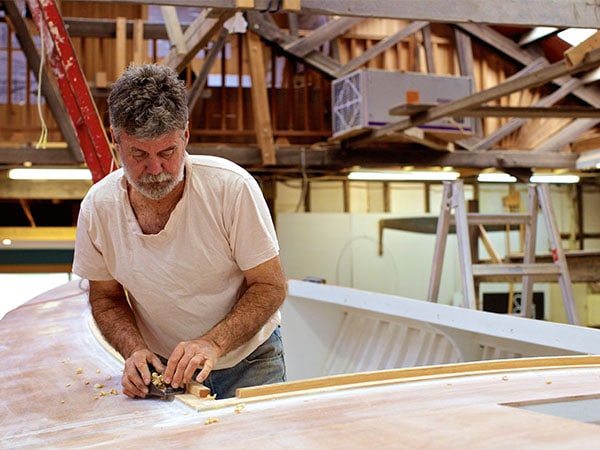
Discover exquisite traditional craftsmanship at The Wooden Boat Centre. (Image: Tourism Tasmania & Adrian Cook
We get even closer to the water on kayaks with a guided tour with Esperance Adventures, gliding through the placid waterways of Port Esperance Bay and French navigational and colonial history.
The vibrant yellow of our crafts dissects the blues of waterways and the distant Hartz Mountains as we pass the islands of Faith, Hope and Charity, the middle one once acting as a probation island for convicts trialling freedom and producing food for the area.
We gather shells that speak of the abundant supply of sea treasures – oysters, abalone, scallops and more – favoured by the local Palawa peoples long before colonials arrived.

The beautiful Hartz Mountains are on the Southern end of the Huon valley, providing a dramatic backdrop to the region. (Image: Stu Gibson)
Digs for the evening is the delightful Beaupre Cottage in rural Lymington on a working goat farm, but for guests it’s total relaxation. Here choices must be made: a private beach to wander, goats to meet, kayaking or cycling to be done, and walks to take with resident Border Collie, Beau. It’s a real treat.
As far south as the road will take us lies Recherche Bay, a place of tranquillity with a scattering of ‘shacks’ at Cockle Creek and an abundance of secluded white beaches, shore birds and wildlife. We opt for the stunning two-hour coast-hugging, rock-clambering walk to Fishers Point (best taken at low tide) with views for days, and breathe in the calm.

Take in a serene ocean view at Cockle Creek, Australia’s southernmost drivable location. (Image: @huonvalleycouncil)
The reputation of Tasmania’s south-west as a region of remarkable beauty notwithstanding, I’m unlikely to venture too deeply into its spectacular wilds, but Tahune Adventures right at its edge near Geeveston provides a perfect alternative.
It’s there we take the 600-metre airwalk through the forest canopy, 50 metres above the Huon River with glimpses into the mountains of the Tasmanian Wilderness World Heritage area beyond, walk along the suspension bridges and wander the fern-filled walk at ground level.

Relax at the Huon river, surrounded by luscious forests. (Image: Christine Aldred)
Fully accessible to wheelchairs, prams and even dogs on leads, it’s a forest experience anyone can take part in and witness some of the region’s recovery after devastating bushfires in 2019. For those yearning for an adrenaline kick, the ‘eagle’ zipline provides another view.
We’ve put down an impressive daily step count so it’s fortunate a special treat awaits at Fair Winds, our luxury home for the evening at Brooks Bay with stunning vistas and an outdoor tub from which to soak it in.
As if that’s not enough, we up the ante with our own private chef: ex-MasterChef contestant Sarah Clare is now sharing her skilful delight in food through Essentially Tas, which provides accommodation options with home dining add-ons.
The evening’s fare is local, seasonal produce, driven by Sarah’s belief we should know where our food comes from: ‘I don’t want my food to have travelled further than I have.’
Her love of foraging is evident: there are three types of fish she caught the day before, leeks from her garden, lemons from her dad’s and samphire from the sea, and that’s just for starters, with local wines of course. It’s an exceptional evening all round.
Wherever we go, the themes of local produce and food communities abound. At nearby Geeveston, a quaint timber town, we lunch at Harvest and Light, a small-batch picklery with a photographic gallery on the side, where Sarah also works.

Geeveston is a character-filled country town in the Huon Valley. (Image: Tahune Adventures Geeveston)
There, pickler and photographer Cassy Faux preserves myriad fruit and veg and offers pretty-as-a picture tasting plates with a selection of cheeses, along with local beverages.
The ‘honour wall’ next to the kitchen is a shout-out to the host of locals who’ve donated produce to be converted into pickles, preserves and even fruit syrups. This week it’s grapefruits, sometimes zucchinis or lemons, but whatever it is, Cassy is always grateful as it echoes her overriding business ethos of minimising waste and connects her to the local community.
In the Italian way, Martino Crippa and Sofia Panfili, of Osteria at Petty Sessions, in Franklin’s old courthouse, make most of the food they serve from scratch: prosciutto and coppa, preserved fish, ricotta, their ‘kick-ass tiramisu’ and, of course, pasta.
While their Umbrian heritage features strongly at their restaurant, they also incorporate a lot of local produce, grown by neighbours and friends, like the apples and blueberries in the dessert terrine with ice-cream. Don’t miss the light as-a-feather gnocchi.
Port Cygnet CanneryAt Port Cygnet Cannery, once the hub of Cygnet’s economy as an apple cannery factory, it’s no longer just about the pizzas created in ‘Dante’, the Italian pizza oven that takes pride of place in the middle of the restaurant.

Indulge in a slice at the iconic Port Cygnet Cannery.
After its recent ritzy makeover, the weekend feasts of garden goodness – fresh from nearby Gardners Bay Farm, its sister enterprise – are now pulling the crowds, too.
We’ve toured the farm with the gardener, learnt about soil biology, felt the compost and plucked purple beans from the vines, so we feel connected to our meal and the people who grew it.
In fact, it’s all very connected. The Huon Valley offers a dozen road trips in one compact space and it’s up to you to choose your own flavour. Whichever road you travel, another adventure awaits: cool-climate wineries, cideries on tap, thermal springs and ancient crystal caves for starters. And with scenery like this, who cares if there’s a little backtracking here or there?
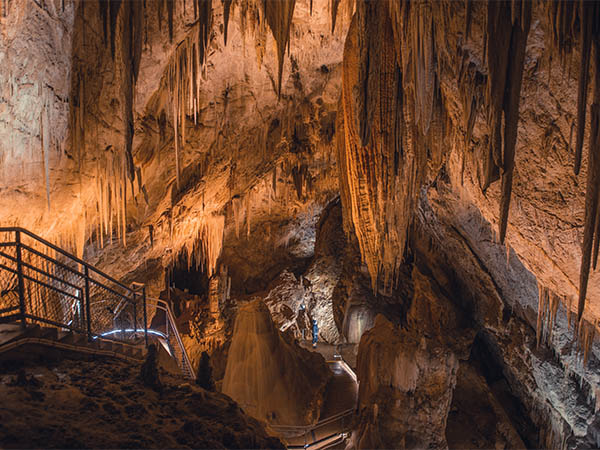
Explore Tasmania’s otherworldly crystal caves. (Image: Jess Bonde)
Southwest National Park offers limited free camping at Cockle Creek (parks pass required) on a first-come first-served basis. BYO fresh water and supplies. To extend your forest exploration, Tahune Adventures offers caravan and campervan sites for $10 a night with purchase of entry ticket or simple two-bedroom cabins.
Frida – a teal 1975 VW Kombi – provides charming creek-side accommodation with boho or retro vibes in a private patch of country bliss in Upper Woodstock. Fully off-grid, Kombi Kamp includes a kitchen hut with pot-belly stove, fire pit for roasting marshmallows, fairy lights and homemade treats. Bathe in the bubbling creek or shower under the stars, and bask in the serenity.

Recharge in Retro style in Frida, the teal 1975 Kombi with lots of character.
Villa Talia is set on four hectares a five-minute drive south of Franklin. This luxury three-bedroom villa offers an indulgent outdoor lounge and dining space, an infinity lap pool, private yoga lessons by request and garden, river and mountain views all at once.
Words by Christine Aldred
Peruse Australia’s largest outdoor art gallery on a road trip through the under-the-radar towns of Victoria’s Wild West.
Wimmera Mallee is a prolific grain-growing area that’s home to many small, vibrant communities whose locals are being recognised and celebrated through a 200-kilometre Silo Art Trail.

Kick off a tour of the Silo Art Trail at Wimmera Mallee. (Image: Anne Morely)
Brim, Rosebery, Albacutya, Patchewollock, Lascelles, Sea Lake, Nullawil, Sheep Hills, Rupanyup, Goroke, Kaniva and Serviceton are linked through a series of huge murals writ large on the sides of grain silos – many of which date back to the 1930s.
The creators, who are some of the world’s most celebrated street artists, visited and spent time engaging with their respective host towns in order to capture their spirit in a unique art project that is still evolving.
Highlights include Guido van Helten’s iconic mural in Brim depicting a multi-generational quartet of female and male farmers, the first silo artwork to appear in Victoria, and the inspiration for the project itself; Rone’s reflection of local farming couple Geoff and Merrilyn Horman in Lascelles; Russian mural artist Julia Volchkova’s impression of rural youth culture in Rupanyup; and Matt Adnate’s celebration of Wergaia Elder Uncle Ron Marks and Wotjobaluk Elder Aunty Regina Hood in Sheep Hills.
In between eyefuls of art, stop at country pubs for hearty meals, browse in quirky stores and seek out unique heritage and culture at places like Dimboola Print Museum, the site of the former local newspaper with its still-operable printing presses and associated machinery on display.

Marvel at these magnificent murals that turn the countryside into an open-space gallery. (Image: Anne Morely)
The Silo Art Trail is 200 kilometres.
After being purchased by a group of locals, the 10-room Royal Hotel Sea Lake has been restored to its former glory.
Dubbo is a no-brainer on any regional NSW road trip – especially with kids in tow; the thriving city on the cusp of the outback offers one of Australia’s most singular attractions by way of an African safari experience at Taronga Western Plains Zoo.
But the region harbours a bounty of hidden gems that add up to a mini adventure in their own right: from the nature-steeped town of Wellington, a 30-minute drive south-east of Dubbo City, which lies in the foothills of Mt Arthur Reserve (refuel post-bushwalk at 1950s-style diner Milky Daze); to the unique alpaca farm and gallery Quentin Park (meet the furry creatures and picnic in a paddock); to Waverleigh cotton farm in Narromine and Orana Cactusworld in the small town of Gilgandra, where up to 1000 varieties of prickly cacti are ripe for exploration.

Take a stroll at Mt Arthur reserve and discover the many scenic lookout points.
(Image: Destination NSW)
338 kilometres round trip.
Taronga Western Plains Zoo offers lodges, cabins and camps for overnight stays.

The view of the giraffes from the front of a Zoofari Lodge at Taronga Western Plains Zoo.
“Welcome to Burgundy”, says winemaker Richard De Beaurepaire, while walking us around his vineyard outside the Central NSW country town of Rylstone.
“Here, we’ve got the same soil structure, the same alkalinity, climate and temperature range as the great vineyards of Burgundy, where wine is the liquid expression of the land,” says De Beaurepaire, who settled on the region in 1998 when he had the revelation the limestone-enriched location and cool climate would allow him to produce the terroir-driven wines that lean into his French heritage.
After an immersive guided Vigneron Experience with De Beaurepaire, we gather for a tasting led by his daughter, Amanda, in the cellar door housed in 170-year-old stables. We also get a taste of the terroir at Lowe Family Wine Co, an hour’s drive away in Mudgee, where vines have been threaded onto the property, like dainty needlework, since 1973.

Enjoy a quintessential country experience at Lowe Family Wine, a biodynamic vineyard, winery and farm.
The sprawling Tinja family property now includes a tiered lawn bar, award-winning restaurant, Zin House, and rustic cellar door. Our food-and-wine-focused tour of the region also includes a visit to Three Tails Brewery and Smokehouse, housed in a heritage building in Mudgee (the town’s original post office), yum cha at 29 nine 99 on the cobblestoned main strip of Rylstone, and a five-course Warakirri Dining Experience at Indigiearth that showcases native ingredients found on Wiradjuri lands.
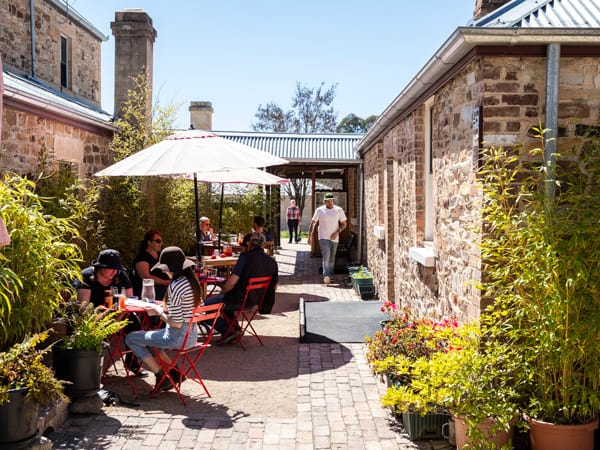
Take a detour to Rylstone for lunch at 29Nine99 Yum Cha. (Image: Destination NSW)
The drive from Sydney to Mudgee takes roughly three and a half hours; from Mudgee to Rylstone is 40 minutes.
Seek out eco-friendly accommodation at Strikes Mudgee, Glenayr Farm and Evamor Valley.
Words by Carla Grossetti
Swap the white sand of Queensland’s coast for the red dirt of the outback with lashings of warm country hospitality by heading west 750 kilometres from Brisbane – stopping in Dalby (for lunch at Urban Paddock Cafe), Miles (for a tour of the historical village museum and overnight at Swagsman Motor Inn) and Roma (browse local crafts at Calico Cottage en route) – until you hit Charleville.
Its unique experiences beg for a few days’ stay: meet bilbies and learn how this endangered species is being protected; study the stars at the Cosmos Centre; discover the role the town played during the Second World War; and stay at the historic Hotel Corones. Then travel to vast Charlotte Plains Station and wash the red dirt away in an outdoor bath heated by bore water.

Discover the serenity and stunning beauty of regional life on the Charlotte Plains. (Image: Tourism And Events Queensland)
1710 kilometres.
Words by Jennifer Johnston
See Ned Kelly’s armour at the State Library Victoria in Melbourne, then drive north on the Hume Freeway towards bushranger country where rollicking tales of folk heroes, murder and mayhem abound.

Ned Kelly was one of the last bushrangers– but also one of the most infamous.
See art depicting bushrangers at Benalla Art Gallery, take cheesy photos with Glenrowan’s Ned Kelly statue, and visit Wangaratta Cemetery to see ‘Mad Dog’ Morgan’s grave.
Finish at Old Beechworth Gaol, where the Kelly Gang, ‘mature-age’ bushranger Harry Powers and other outlaws did time. Such is life.

Step back in time and discover bushranger history across Victoria. (Image: Visit Victoria)
290 kilometres
Bed down at Marlo Cottage in Beechworth, where the Kelly Gang were once photographed.
Words by Jo Stewart
Flanked by gently rumpled farmland where sheep huddle together for warmth, the Midland Highway linking Launceston and Hobart is hardly Tasmania’s most scenic drive and the 16 roadside silhouettes of stagecoaches, surveyors and soldiers that line the route provide a welcome distraction.
But a key element was missing from these colonial scenes until this year. Commissioned by Mona Foma festival, Trawlwoolway artist Julie Gough’s additions, The Missing, depict all-too-common acts of state-sanctioned violence in the colony’s early days, but they also look further back.

‘The Missing’ is a powerful artwork that confronts Australia’s history of colonial violence. (Image: MONA/Jesse Hunniford)
On a hillside surrounded by knee-high grass, a lone figure with a fire stick represents 10,000 years of traditional land management practices. From another angle on the return journey, it serves as a literal torchbearer for future generations.
200 kilometres
When you arrive in Hobart, get a closer look at some iconic local artworks with a stay at Mona Pavilions.

Relax in style at Mona Pavillions, contemporary accommodation just a short distance from Hobart. (Image: Brett Boardman)
Words by Alexis Buxton-Collins
You know exactly what you are going to get on a road trip of the Scenic Rim – it’s right there on the packaging.
One drive in particular, from Binna Burra Lodge to O’Reilly’s Rainforest Retreat allows you to experience all its best bits in the one go, from unique luxury digs to stunning scenery to gourmet treats.

Recharge in a rainforest retreat and take in the serene ambience of nature. (Image: Tourism And Events Queensland)
It’s easy: head down the mountain from Binna Burra to Canungra along Beechmont Road, stopping for lunch at Canungra Hub Cafe and grabbing some Greenlee Farm macadamias; continue to Sarabah Estate Vineyard for a tasting and some takeaway, then it’s back up the mountain at the other end of the breathtaking Lamington Plateau to O’Reilly’s for the night.
70 kilometres
In ordinary times, the Northern Rivers lays out a welcome mat of idyllic coastlines and lush, canopied hinterlands romped through merrily by seasonal hordes of holidaymakers. But these are less-than-ordinary times and, for years now, usual touring has been hampered by a doubling down of disasters.

The Northern Rivers are characterised by stunning coastlines and vibrant beach towns. (Image: Destination NSW)
For much of the country at least, the pandemic has been overlaid with natural disasters, from drought to bushfires, and now, for the Northern Rivers in particular, the extraordinary flooding along the east coast. And while, yes, there are many rivers here, this unprecedented deluge has left townships and lives destroyed, and those who love and visit the area wringing their hands with helplessness.
But the best thing you can do is continue to go. Spend your money in towns that are still painfully trying to reassemble themselves, support local businesses and producers, and visit hard-hit places you may not usually add to your route.
It’s time to hit the road empty-eskied on a road trip to fill the cup of those in need. But this is not solely altruistic travel, there are plenty of gems to discover along the way, too.

Take a dip at one of the world-renown beaches along the Northern Rivers – you’ll be spoilt for choice. (Image: Elise Hassey)
Yamba, edged by the Pacific Ocean and the Clarence River has recently opened its first boutique hotel, The Surf, to much applause, but there are also plenty of adorable holiday lets you can use as a base to explore the incredible produce of the region.

Kick back in style at The Surf Yamba (Image: Elise Hassey)
Farmers have suffered crop and livestock loss due to the floods, so stock up on local goods and show support at the Yamba Farmers and Producers Market every Wednesday.
Spread the love around hard-hit hospitality places and make bookings at refined local eateries such as Barbaresco and Karrikin.
The Mullumbimby Farmers Market is hands-down the best in the Byron Shire. While the town itself was largely submerged during the floods, the local producers were also saddled with fruitless harvests and lost market days, so come along with an empty basket on Fridays to relish the particularly Mullumbimby vibe this shopping event is loved for. Pick up everything from fresh bread, breakfast and coffee, to sprouts and fungi.
The mountain-shadowed township also has plenty of wonderful eateries, such as pizza bar Milk & Honey and Wandana Brewing Co, as well as cutely curated boutiques.
Mullum makes a lovely side trip from Byron, but it’s also a destination in itself. Stay a while in the hinterland calm away from the famous beach hub, but with eyes on it, at Blackbird.

Discover the flavours of local produce at the Farmer’s Markets in Mullumbimby.
This gorgeous riverside town and her rural surrounds have been cultivating some under-the-radar appeal for a while. It’s known for its lively art scene, but unfolding quickly behind is an excellent culinary story.
Include Tweed River House, Bistro LIVI and Husk Distillers in your itinerary. And, of course, take in the M Arts Precinct in town and the Tweed Regional Gallery.
Shouldered by the protective sentinel of Mt Warning, which you’ll glimpse from almost every perspective, Mur’Bah, as the locals call it, is bordered by foothills and rural beauty. Settle in to take in this beauty in a luxury cabin at Mt Warning Estate.
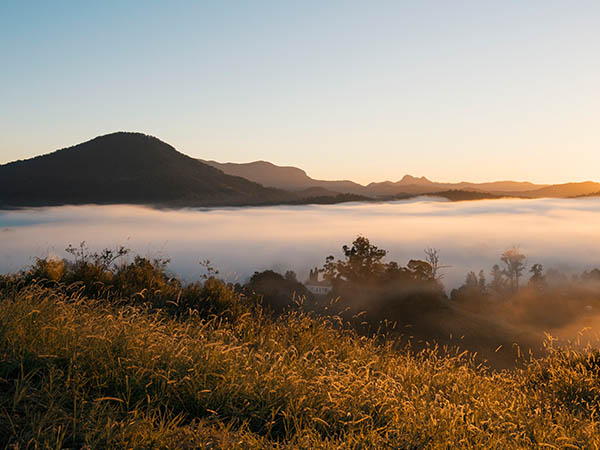
Discovery scenery that will mystify the senses in Murwillumba’s stunning surrounds. (Image: Destination NSW)
Although no stranger to rising waters, historic Lismore was hugely devastated by the unfathomably deep flooding. This university city doesn’t often find itself in the tourism spotlight, but that’s a shame because there’s plenty to discover in the Richmond Valley.
Swing by alternative Nimbin, hike the Nightcap National Park, and admire the works on display at hard-hit Lismore Regional Gallery, then drink to Lismore’s future with a well-mixed cocktail at Augustine’s Wine Bar. Bed down in the stylish rooms above the Eltham Hotel in the beautifully bucolic Eltham village.

Rest and restore at the stylish Eltham Hotel, located in the quaint Eltham village. (Image: Jessie Prince)
The villages of Clunes, Bexhill and Eltham sit between Bangalow and Lismore and are adorable fuel stops on a run to Lismore and beyond.
Make time for a pint and lunch at the tenderly reimagined and very cool Eltham Hotel; stop for a coffee and a bite at the Clunes General Store, which moonlights as a cafe, post office and elegantly curated cellar; and similarly, pause at the Bexhill General Store for a chicken roll.
As the waters began to recede, so too did some of the help. But there’s still loads of rebuilding, cleaning and healing to be done. While simply spending time and money in these embattled regions will do good, you can also log into local flood relief and support Facebook pages to find out exactly what kind of donations and help is needed, such as the Northern NSW 2022 Floods Community Clean Up & Help.
Many community organisations need hands-on help with sorting donations already given, while others are calling for tradespeople to donate their time to help people rebuild. Others, who are currently homeless, simply ask for tents and marquees for shelter, groceries and fuel cards.

Help the communities of the Northern Rivers get back on their feet by donating time and supplies. (Image: Destination NSW)
Linking Wangaratta and Bairnsdale, Australia’s highest year-round accessible sealed road is best experienced in autumn, where there’s no need for snow chains and the landscapes could be mistaken for a watercolour painting.
Travelling along the Great Alpine Road from Wangaratta, you’ll reach Bright in an hour. During autumn, Bright’s many deciduous trees turn warm orange, golden yellow and deep vermillion hues.

Bright comes to life when it’s surrounded by the red-gold hues of autumn.
Unsurprisingly, this region excels at all things autumn. From a mountain-crafted chocolatey stout at Bright Brewery, to a glass of Rutherglen red by the Wandi Pub fireplace, there’s no better place to dedicate yourself to autumnal pursuits.
The next morning, drive to Bents Lookout at Mt Buffalo National Park to take in blockbuster views and get punch-drunk on alpine air. Afterwards, drive towards Mt Hotham and Dinner Plain, where the mountainous terrain makes for intense driving. Go slow as there are feral deer, super-steep inclines and hairpin turns to negotiate.
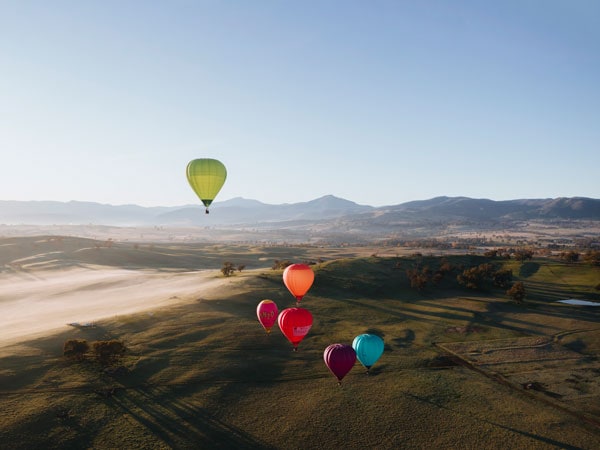
Hot air balloons over Mt Buffalo National Park. (Image: Visit Victoria)
Towards Omeo, you’ll notice splashes of autumn foliage and, if the striking Art Deco facade of the Golden Age Hotel Motel doesn’t win you over, the hearty pub meals will.
Overnight in Omeo, then start your final leg. Swifts Creek Bakery is the perfect pit stop for old-school bakery classics. From there, it takes 80 minutes to reach Bairnsdale, the end of the Great Alpine Road where you can enjoy life in the slow lane at the Gippsland Lakes.

Marvel at the scenery that flanks the winding road along the Great Alpine Way. (Credit: Visit Victoria)
303 kilometres
Retreat to the Kilnhouses, located on a working cattle stud in the blissfully bucolic Ovens Valley.

Unwind in front of this blissful view at luxury farm stay accommodation, ‘The Kilnhouses’ (Image: Visit Victoria)
Words by Jo Stewart
From geological wonders such as dazzling blue lakes and sinkholes, to some of the country’s best food and wine (think award-winning wagyu and robust reds to pair perfectly), and quintessential seaside towns to slow down in, South Australia’s Limestone Coast has something to offer all road-trippers.
Drive along the state’s south-east edge from the saline lagoon of Coorong National Park all the way to the Victorian border, stopping at Robe’s 12-kilometre-long Long Beach, for some of Australia’s best sand driving.
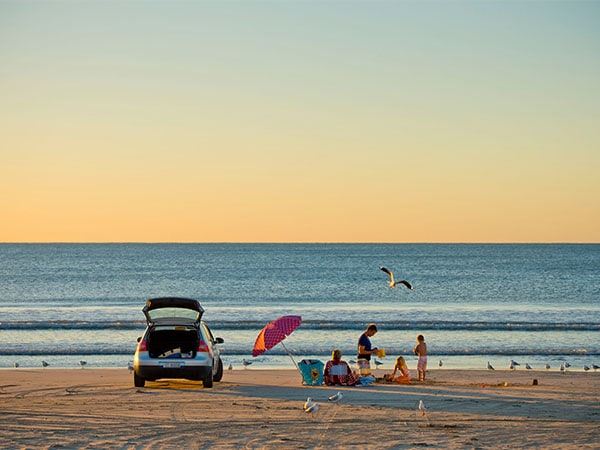
Enjoy the sunset along the picturesque coast. (Image: South Australian Tourism Commission)
The Limestone Coast stretches for more than 400 kilometres; extend your trip by following the Southern Ocean Drive, which also takes in Kangaroo Island and the Fleurieu Peninsula.
Constructed with materials salvaged from local shipwrecks, lovingly restored Airbnb Mrs Banks is the second oldest house in Robe.
The drive to the Central Tablelands city of Bathurst is often overlooked by weekend road-trip warriors, who stop at Blackheath when doing the Blue Mountains thing, or pass it by on their mission to reach Mudgee or Orange in good time. But both the drive to Bathurst and the allures of this NSW city are worth their own entry.
The journey starts to get interesting once you have descended the escarpment at Mt Victoria and are presented with infinite rolling fields and hills (complete with everything from alpaca to cows to horses) and behemoth rock formations on the driver’s side.
The historic town of Hartley is worth a 10-minute stop to wander past its honey-toned late-Georgian and early-Victorian sandstone buildings, some of which are now quizzically grand for such a lonely outpost, before continuing on towards Lithgow, where you’ll skirt the edge of the town along the Great Western Highway.
Keep your eye on the prize and eschew a pit stop in favour of more time at the end of the journey, which continues on a long, largely flat trajectory past grazing fields and thick bush punctuated by turn-offs for charming little towns like Portland, Wallerawang and the enigmatically named Napoleon Reef.
Once in town, drive along the wide streets lit with heritage lamp posts, past grand civic buildings and Machattie Park with its delightful Begonia House, browse the shops and grab something to eat at one of its cafes.

Lose yourself among the unique and fascinating rock formations at the Gardens of Stone National Park. (Image: Destination NSW)
200 kilometres from Sydney.
Among the sheep at the sustainable and chic Farmers Hut at Wilga Station.

Experience idyllic country life in style at Wilga Station. (Image: Leigh-Ann Pow)
The fastest way to drive from Margaret River to Albany is via Manjimup and the Muir Highway. But what’s the rush? Take your time and create mini diversions to enjoy along the way.
The Margaret River region is world-renowned for its food and wine, so make sure to factor in a few wineries, distilleries, microbreweries and restaurants to your itinerary.
Climb the Gloucester Tree, stretch your legs around the Big Brook Dam, go 4WDing in Yeagarup Dunes, and wander along the Valley of the Giants Tree Top Walk.

Gain a new perspective and walk among the lush canopies at the Valley of the Giants Tree Top Walk (Image: Tourism WA)
Oh and you can’t miss the Conspicuous Cliff. Literally. There are also native forests to hike around and beautiful bays and beaches that necklace the coast near Denmark. Then take the Lower Denmark Road to Albany to see some of the stunning beaches at West Cape Howe.

Discover the many pristine beaches scattered along the Muir Highway.
It’s 350 kilometres as the crow flies between Margaret River and Albany, which takes about four hours non-stop. You will have to factor in additional travel time to include a few of the aforementioned detours.
Break up the return drive from Albany to Perth by bunkering down for the night at the Tree Chalets in Busselton.
Words by Carla Grossetti
For the  best travel inspiration delivered straight to your door.
best travel inspiration delivered straight to your door.
Yes just came back from a regional trip – Dubbo-Wellington-Mudgee- Gulgong and Dunedoo then back home to Sydney. Stayed at a wonderful Airbnb in Mudgee which we based our stay. We need everyone to get out visit these little towns on the way as they are magicial they need our support to stay open. Gulgong is an old mining town and is hertiage listed. Dunedoo (just for the name) but a very busy little town. Little towns like Birrawa – Capertee- and all the little towns Castlereagh Highway.